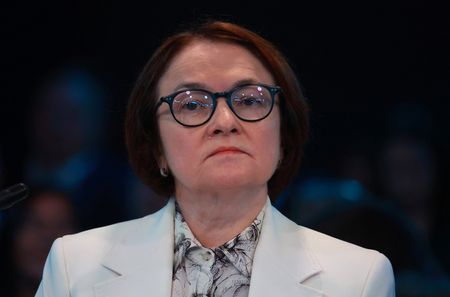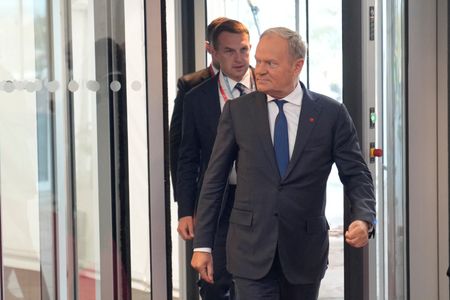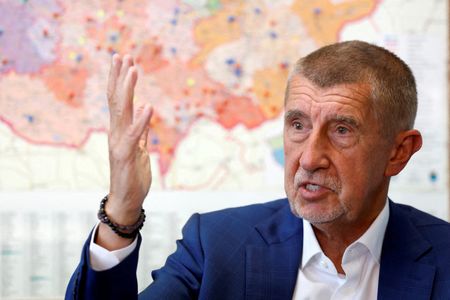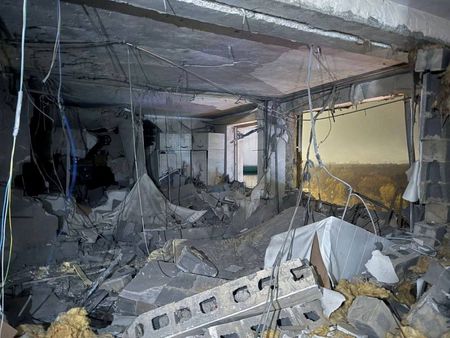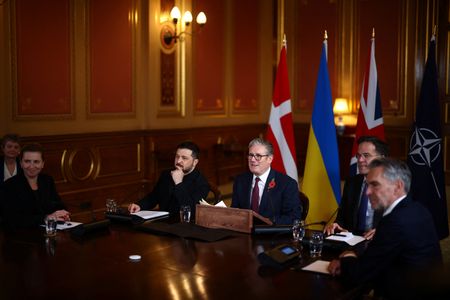MOSCOW (Reuters) -Russian Central Bank Governor Elvira Nabiullina and her deputy Alexei Zabotkin addressed a news conference on Friday after the central bank cut its interest rate by 50 basis points to 16.5%.
Nabiullina and Zabotkin spoke in Russian. The quotes below were translated into English by Reuters.
NABIULLINA ON THE OPTIONS FOR FRIDAY’S RATE DECISION
“Three options were considered in detail: 16%, 16.5%, and an unchanged rate of 17%.
“There were many arguments for these choices, but the differences in positions can probably be reduced to the assessment of stable inflation and the degree of concern about the scale of possible secondary effects from one-off pro-inflationary factors.”
NABIULLINA ON THE IMPACT OF WESTERN SANCTIONS
“The sanctions are primarily aimed at restricting exports of our raw materials. It’s difficult to predict the exact impact of these sanctions, but we view them as a negative external factor.
“Much will depend on how we adapt to these sanctions. We know from previous periods that it takes a certain amount of time, but adaptation did happen. Therefore, it isn’t necessary yet to assess whether this will require any changes in monetary policy decisions. We will see how the situation develops.”
NABIULLINA ON FUTURE RATE DECISIONS
“I believe that we are in a cycle of monetary policy easing, either way. It may happen with pauses, but you can see the trajectory of the rate that we have set for next year, which is a continuation, albeit a more cautious one, of monetary policy easing… We see that demand growth is slowing down, demand overheating is subsiding, and we expect the demand gap to close in the first half of next year.
“Our forecast, if you look at the trajectory of the key rate, including for this year, suggests the possibility of both an additional reduction at the December (rate-setting) meeting and an unchanged rate.”
NABIULLINA ON THE LABOUR MARKET
“…tensions on the labour market are also easing slightly… We see that the number of vacancies is decreasing. The (labour market) survey shows that the share of companies experiencing a shortage of personnel is also decreasing. Although the number of these companies remains high, there is a certain trend towards a reduction in tension in the labour market.”
NABIULLINA ON THE IMPACT OF OIL PRICES ON MONETARY POLICY
“The budget rule essentially neutralises the impact of these oil price fluctuations on our economy. It absorbs, if not all, then the lion’s share of this volatility…(the mechanism) works as long as there are sufficient funds in the National Welfare Fund to neutralise this impact, to compensate for the loss of oil and gas revenues…And if the funds are exhausted, then the effectiveness of the budget rule as insurance against a temporary decline in prices will also be exhausted.
“Therefore, in this regard, we welcome the government’s plan to gradually reduce the cut-off price, as this will help to protect the economy in the long term, to protect the economy and the budget more reliably from oil price fluctuations and from scenarios in which the long-term export price of oil may fall below $60 per barrel.”
NABIULLINA AND ZABOTKIN ON HOW INFLATION EXPECTATIONS COULD DECREASE
Nabiullina: “People’s expectations that inflation will be high will decline only if they see that prices in stores are not constantly rising. If they continue to rise, no matter what we say, people will have high inflation expectations. Therefore, it is essential for us to continue reducing inflation. Lowering and stabilising inflation and inflation expectations at low levels will allow us to reduce the key rate more quickly.”
Zabotkin: “If inflation expectations are low and anchored, the Central Bank needs to react less with interest rates to short-term fluctuations in inflation in order to keep inflation low in the future. The more anchored inflation expectations are, the less monetary policy needs to react to demand shocks.”
*NABIULLINA AND ZABOTKIN ON GEOPOLITICS’ IMPACT ON ROUBLE EXCHANGE RATE
Nabiullina: “We must admit that our exchange rate has become more volatile. Depending on the combination of these factors, it can react to them in completely different ways. The exchange rate fluctuates within a relatively stable range. In fact, we should not look at these short-term fluctuations, but rather at longer periods.
“I would like to point out that, in addition to exports, imports, capital flows, and our monetary policy, structural factors are now influencing the exchange rate…Internal factors include import substitution, protectionism, localisation requirements, and requirements to purchase domestic products within the public sector and for government orders. These factors will objectively restrict imports and, all other things being equal, will objectively lead to a smaller share of imports in GDP. It should be understood that this will result in a stronger exchange rate.
“The second long-term factor is a decline in demand among our citizens for foreign assets – currency, foreign securities, industrial assets in ‘unfriendly countries’ – due to sanctions risks and restrictions. And third, an increase in the budget cut-off price. In essence, this means more active use of oil and gas rents. This also leads to a structurally stronger real exchange rate. “
Zabotkin: “Here I will repeat once again what we constantly remind ourselves of: if our monetary policy is aimed at low inflation, it automatically protects the purchasing power of the national currency not only in relation to goods and services, but also in relation to other foreign currencies, except for severe external shocks, which, of course, can lead to changes. But overall, exchange rate stability is a consequence of a policy aimed at low inflation — and only that.”
(Compiled by Lucy Papachristou; Editing by Mark Trevelyan/Andrew Osborn)

